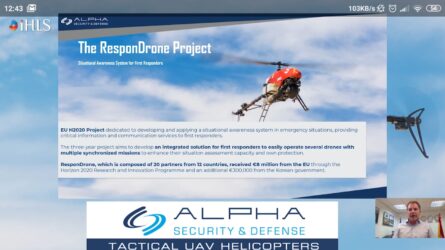ResponDrone platform using advanced Thales IR/EO camera payload of high mission-relevance for use in war on COVID-19 outbreak
May 4, 2020
The key role played by drones in the global effort to overcome the COVID-19 virus is an issue that has gained widespread resonance in recent months.
Beyond the salient advantages of using a remotely piloted platform (operator safety, cost, flexibility, etc.), perhaps their real competitive advantage or ‘secret weapon’ lies in the functions and capabilities of the payload the drones are equipped with to perform their mission. Commonly used payloads include surveillance equipment, package delivery or loudspeaker systems.
One of the prominent payloads to enter into service in the ResponDrone project is a high-end camera system produced by Thales, a ResponDrone partner.

The core of this cutting-edge technology is an imaging system composed of two complementary cameras: a visible or electro-optical (EO) sensor and an infrared (IR) sensor. The camera payload’s ability to span both visible and IR wavelengths is the key to enabling enhanced situational awareness not only during daytime, but also at night or in conditions of poor light.
This highly agile camera payload is destined to perform a multitude of mission-relevant tasks within the scope of the ResponDrone project.
Firstly, it is more than appropriately designed for use in performing people and vehicle detection/tracking in Search and Rescue (SAR) scenarios. In order to do so, it is equipped with a full HD camera featuring 360x zoom (30x optical and 12x digital zoom), high sensibility capabilities including noise reduction, slow AE response, visibility enhancer, flicker compensation and Wide Dynamic Range (WDR).
At the same time, by means of its state-of-the-art IR sensor, the camera system is able to monitor, analyse and track the evolution of fires, which is a crucial tool for managing large-scale natural disasters. An additional key benefit of the Thales camera system is its high-quality onboard hardware, which is capable of processing the incoming data and images in real-time. This is evidently a critical capability in dealing with highly time-sensitive situations, where life is at stake.
This entire capacity is provided by a camera payload system with an overall weight of no more than 1.5kg.

There are a growing number of national and international initiatives using drones in the current COVID-19 crisis, in a variety of mission scenarios, and they are rapidly becoming a real “game changer”. These include surveillance and monitoring missions, information distribution by loudspeakers or healthcare delivery missions to infected areas.
One promising and highly valuable mission category for utilizing drones equipped with highly sensitive IR cameras is to detect citizens with an elevated body temperature, as this can be an important early indicator of a Coronavirus carrier.
One related challenge relies in the measurement of absolute body temperatures, as this requires special calibration procedures in order to provide a reference temperature to the computing algorithm or radiometric IR cameras which are heavier, bigger and more voluminous.
These examples graphically highlight the potential benefit to be gained by the use of the core technology in the ResponDrone platform, as well as the wider relevance of the project to contending with natural disasters, such as the COVID-19 virus that is currently the leading global challenge.



